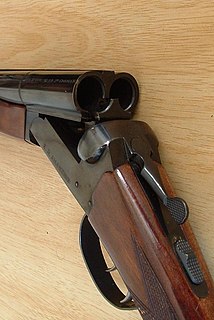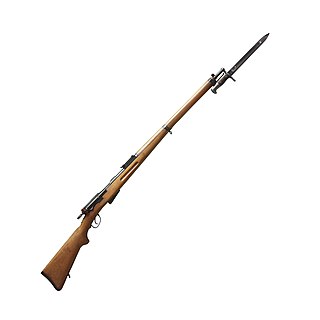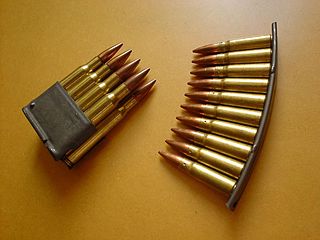
Waffenfabrik Bern (Weapons Factory Bern), also known as W+F Bern, was an arms manufacturer in Bern, Switzerland, which was a government-owned corporation producing firearms for the Swiss Armed Forces.

Waffenfabrik Bern (Weapons Factory Bern), also known as W+F Bern, was an arms manufacturer in Bern, Switzerland, which was a government-owned corporation producing firearms for the Swiss Armed Forces.

Bolt action is a type of manual firearm action that is operated by directly manipulating the bolt via a bolt handle, which is most commonly placed on the right-hand side of the weapon.

In firearms terminology, an action is the functional mechanism of a breech-loading firearm that handles the ammunition cartridges, or the method by which that mechanism works. Actions are technically not present on muzzleloaders, as all those are single-shot firearms with a closed off breech with the powder and projectile manually loaded from the muzzle. Instead, the muzzleloader ignition mechanism is referred to as the lock.
A semi-automatic firearm, also called a self-loading or autoloading firearm, is a repeating firearm whose action mechanism automatically loads a following round of cartridge into the chamber (self-loading) and prepares it for subsequent firing, but requires the shooter to manually actuate the trigger in order to discharge each shot. Typically, this involves the weapon's action utilizing the excess energy released during the preceding shot to unlock and move the bolt, extracting and ejecting the spent cartridge case from the chamber, re-cocking the firing mechanism, and loading a new cartridge into the firing chamber, all without input from the user. To fire again, however, the user must actively release the trigger, allow it to "reset", before pulling the trigger again to fire off the next round. As a result, each trigger-pull only discharges a single round from a semi-automatic weapon, as opposed to a fully automatic weapon, which will shoot continuously as long as the ammunition is replete and the trigger is kept depressed.

The Schmidt–Rubin rifles were a series of Swiss Army service rifles in use between 1889 and 1958. They are distinguished by the straight-pull bolt action invented by Rudolf Schmidt and use Eduard Rubin's 7.5×55mm Schmidt–Rubin rifle cartridge.

Peter Paul Mauser, after 1912 von Mauser, was a German weapon designer, manufacturer/industrialist and politician.

A clip is a device that is used to store multiple rounds of ammunition together as a unit for insertion into the magazine or cylinder of a firearm. This speeds up the process by loading the firearm with several rounds at once, rather than one at a time. There are several types, most made of inexpensive stamped sheet metal, intended to be disposable, though they are often re-used.

The M1901 Mannlicher Self-Loading, Semi-Automatic Pistol was an early semi-automatic pistol design.

The Mannlicher M1895 is a straight pull bolt-action rifle, designed by Ferdinand Ritter von Mannlicher that used a refined version of his revolutionary straight-pull action bolt, much like the Mannlicher M1890 carbine. It was nicknamed the Ruck-Zuck-[Gewehr] by Austrian troops and "Ta-Pum" by Italian troops who wrote a song (it) about it during World War I. The primary producers were the OEWG in Steyr, and FÉG in Budapest.

Rotating bolt is a method of locking the breech of a firearm closed for firing. Johann Nicolaus von Dreyse developed the first rotating bolt firearm, the "Dreyse needle gun", in 1836. Like the Mauser M 98 or M16, the Dreyse locked using the bolt handle rather than lugs on the bolt head. The first rotating bolt rifle with two lugs on the bolt head was the Lebel Model 1886 rifle. The concept has been implemented on most firearms chambered for high powered cartridges since the 20th century.

The Lee Model 1895 was a straight-pull, cam-action magazine rifle adopted in limited numbers by the U.S. Navy and Marine Corps in 1895 as a first-line infantry rifle. The Navy's official designation for the Lee Straight-Pull rifle was the "Lee Rifle, Model of 1895, caliber 6-mm" but the weapon is also largely known by other names, such as:

Ferdinand Ritter von Mannlicher was a German engineer and small arms designer. Along with James Paris Lee, Mannlicher was particularly noted for inventing the en-bloc clip charger-loading magazine system. Later, while making improvements to other inventors' prototype designs for rotary-feed magazines, Mannlicher, together with his protégé Otto Schönauer, patented a perfected rotary magazine design, the Mannlicher–Schönauer, which was a commercial and military success.
The Karabiner Modell 1931 is a magazine-fed, straight-pull bolt action rifle. It was the standard issue rifle of the Swiss armed forces from 1933 until 1958 though examples remained in service into the 1970s. It has a 6-round removable magazine, and is chambered for the 7.5×55mm Swiss Gewehrpatrone 1911 or GP 11, a cartridge with ballistic qualities similar to the 7.62×51mm NATO/.308 Winchester cartridge. Each rifle included a 6-round detachable box magazine with matching stamped serial number. A stripper clip can be used to load the magazine from the top of the receiver.

The 7.5×55mm Swiss or 7,5mm GP 11 is a cartridge developed for the Swiss Army. It originated from the Gewehrpatrone 1890 (7.5×53.5mm) developed in 1898 by mechanical engineer Lt. Col. Eduard Rubin for rifles based on Rudolf Schmidt's action design. The 7.5×55mm Swiss GP 11 cartridge is similar in appearance to the slightly smaller 7.5×54mm French round though the two are not interchangeable.
The Vetterli rifles were a series of Swiss army service rifles in use from 1869 to 1889, when they were replaced with Schmidt–Rubin rifles. Modified Vetterlis were also used by the Italian Army.

The Mondragón rifle refers to one of two rifle designs developed by Mexican artillery officer General Manuel Mondragón. These designs include the straight-pull bolt-action M1893 and M1894 rifles, and Mexico's first self-loading rifle, the M1908 - the first of the designs to see combat use.
The 6.5×53mmR, originally and more correctly produced as the 6.5x53.5mmR, and in the early Imperial (English) nomenclature also known as the .256 Mannlicher, is a late 19th-century rimmed centerfire military rifle cartridge similar to other early smokeless powder designs.

The Repeating Rifle Model 1886 commonly known as Mannlicher Model 1886 was a late 19th-century Austrian straight-pull bolt-action rifle, adopted in 1886. It used a wedge-lock straight pull action bolt. It was the first straight-pull bolt-action service rifle of any nation.
The Mannlicher M1893 is a bolt-action rifle that was the standard service rifle of the Kingdom of Romania from 1893 to 1938. The rifle and its 1892 predecessor were the first repeating rifles to be widely issued in the Romanian military. It was later replaced by the Czechoslovak-designed Vz. 24 as the standard service rifle.
The Swiss Mannlicher Model 1893 Carbine was a straight-pull carbine designed by Ferdinand Mannlicher for use by the Swiss cavalry troops. It features a bolt that is almost identical to that of the Mannlicher M1890 Carbine and Mannlicher M1895 rifle aside from the shape of the cocking piece.